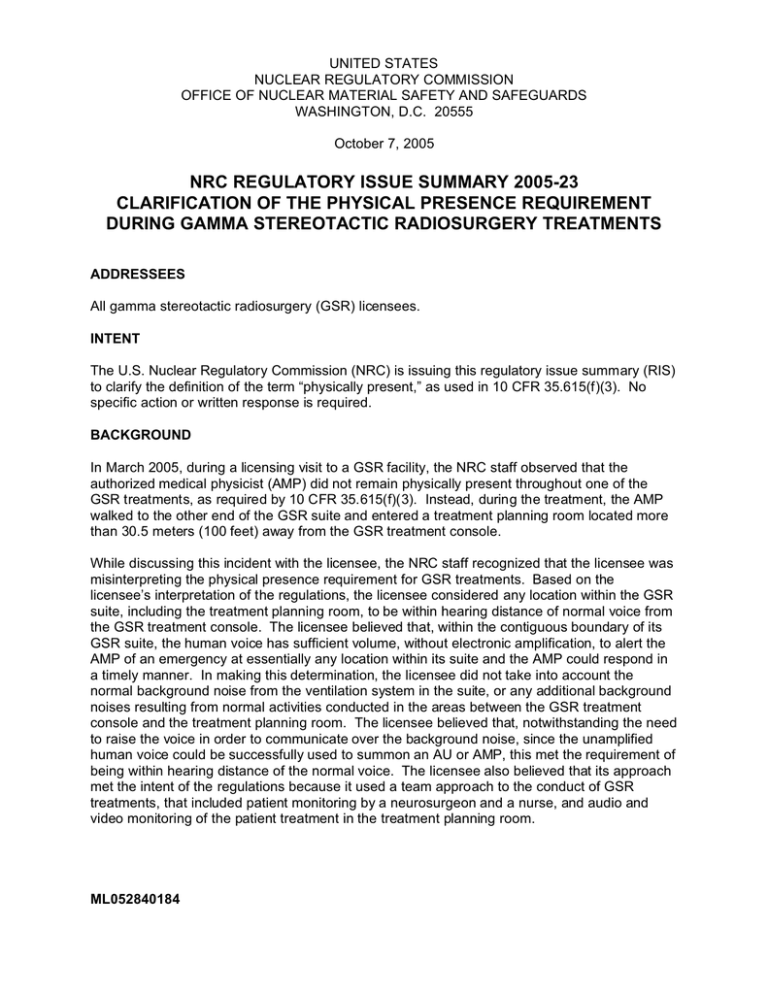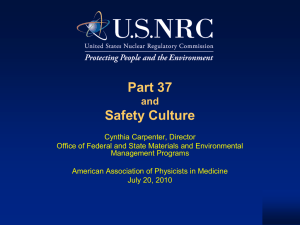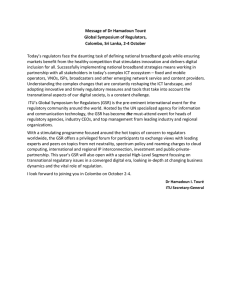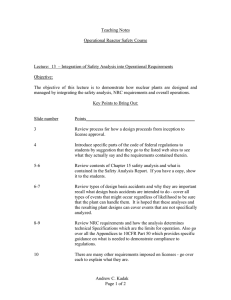UNITED STATES NUCLEAR REGULATORY COMMISSION OFFICE OF NUCLEAR MATERIAL SAFETY AND SAFEGUARDS
advertisement

UNITED STATES NUCLEAR REGULATORY COMMISSION OFFICE OF NUCLEAR MATERIAL SAFETY AND SAFEGUARDS WASHINGTON, D.C. 20555 October 7, 2005 NRC REGULATORY ISSUE SUMMARY 2005-23 CLARIFICATION OF THE PHYSICAL PRESENCE REQUIREMENT DURING GAMMA STEREOTACTIC RADIOSURGERY TREATMENTS ADDRESSEES All gamma stereotactic radiosurgery (GSR) licensees. INTENT The U.S. Nuclear Regulatory Commission (NRC) is issuing this regulatory issue summary (RIS) to clarify the definition of the term “physically present,” as used in 10 CFR 35.615(f)(3). No specific action or written response is required. BACKGROUND In March 2005, during a licensing visit to a GSR facility, the NRC staff observed that the authorized medical physicist (AMP) did not remain physically present throughout one of the GSR treatments, as required by 10 CFR 35.615(f)(3). Instead, during the treatment, the AMP walked to the other end of the GSR suite and entered a treatment planning room located more than 30.5 meters (100 feet) away from the GSR treatment console. While discussing this incident with the licensee, the NRC staff recognized that the licensee was misinterpreting the physical presence requirement for GSR treatments. Based on the licensee’s interpretation of the regulations, the licensee considered any location within the GSR suite, including the treatment planning room, to be within hearing distance of normal voice from the GSR treatment console. The licensee believed that, within the contiguous boundary of its GSR suite, the human voice has sufficient volume, without electronic amplification, to alert the AMP of an emergency at essentially any location within its suite and the AMP could respond in a timely manner. In making this determination, the licensee did not take into account the normal background noise from the ventilation system in the suite, or any additional background noises resulting from normal activities conducted in the areas between the GSR treatment console and the treatment planning room. The licensee believed that, notwithstanding the need to raise the voice in order to communicate over the background noise, since the unamplified human voice could be successfully used to summon an AU or AMP, this met the requirement of being within hearing distance of the normal voice. The licensee also believed that its approach met the intent of the regulations because it used a team approach to the conduct of GSR treatments, that included patient monitoring by a neurosurgeon and a nurse, and audio and video monitoring of the patient treatment in the treatment planning room. ML052840184 RIS 2005-23 Page 2 of 3 NRC determined that the licensee’s approach did not meet the physical presence requirement in 10 CFR 35.615(f)(3) and issued a Confirmatory Action Letter (CAL) to the licensee. The CAL documented the licensee’s commitment to have at least one authorized user (AU) and one AMP physically present at or near each GSR treatment console throughout all patient treatments involving a GSR unit. In its response to the CAL, the licensee committed to having both the AU and AMP remain within approximately 6 meters (20 feet) of the treatment console (an acceptable distance for this particular case) and that the AU and/or AMP would not enter a separate room during a GSR treatment. The licensee further committed that, if simultaneous treatments were to take place at the facility, there would be an AU and an AMP present at each unit. SUMMARY OF ISSUE The regulations in 10 CFR 35.615(f)(3) state: [the licensee shall,] “for GSR units, require an AU and an AMP to be physically present throughout all patient treatments involving the unit.” The term “physically present” is defined in Section V, "Summary of Changes," of the 2002 revised Part 35, as published in the Federal Register on April 24, 2002 (67 FR 20355). It states: “As used in this provision, physically present means to be within hearing distance of normal voice.” The word “normal,” as used in this definition, should be given its dictionary meaning of “regular,” “average,” or “not deviating from an established rule.” Under this definition, a raised voice would not constitute a “normal” voice. Therefore, if an AU or AMP could not hear one another when one is standing at the treatment console and the other at a distance from the console without raising their voices, the requirement of “physically present” would not be met. For GSR treatments, the AU and AMP must be physically located at or near the treatment console such that each can communicate with the other within hearing distance of normal voice. As stated earlier, a raised voice would not constitute a normal voice. If either the AU or AMP enters a separate room or moves to a distance, such that the AU or AMP would need to raise his or her voice to communicate with the individual located at the treatment console, or vice versa, then the physical presence requirement would not be met. In the case where two units are simultaneously used, if these individuals could not hear one another when standing at different treatment consoles without raising their voices, the physical presence requirement would not be met. NRC requires the physical presence of an AU and an AMP throughout all patient GSR treatments to ensure appropriate response to an emergency and to ensure that the correct dose is delivered to the patient. We believe that the inherent risk of the GSR procedures justifies the need for a properly trained AU and AMP to be available at all times to respond to an emergency requiring patient removal. However, the term “physically present” may be interpreted differently, according to the particular circumstances. For instance, to be “physically present” throughout a GSR treatment in a quiet, undisturbed room at a medical facility could permit a larger distance from the treatment console than in a busy, noisy area at another medical facility. As long as the AU and the AMP were able to hear each other without raising their voices, then the physical presence requirement would be met. RIS 2005-23 Page 3 of 3 In terms of using electronic devices to comply with 10 CFR 35.615(f)(3), the NRC staff has clarified that the use of communication devices, such as "walkie-talkies," intercoms, and/or other devices that could be used to amplify the human voice is not allowed. This clarification, as well as other frequently asked questions regarding the physical presence requirement during GSR treatments can be found on NRC’s Medical Uses Licensee Toolkit Web site, at: http://www.nrc.gov/materials/miau/med-use-toolkit/faqs-part35.html. FEDERAL REGISTER NOTIFICATION A notice of opportunity for public comment on this RIS was not published in the Federal Register because this RIS is informational and does not represent a departure from current regulatory requirements. SMALL BUSINESS REGULATORY ENFORCEMENT FAIRNESS ACT NRC has determined that this action is not subject to the Small Business Regulatory Enforcement Fairness Act of 1996. PAPERWORK REDUCTION ACT STATEMENT This RIS does not contain information collections and, therefore, is not subject to the requirements of the Paperwork Reduction Act of 1995 (44 U.S.C. 3501, et seq.). CONTACT This RIS requires no specific action nor written response. Please direct any questions about this matter to the technical contact below, or the appropriate regional office. /RA/ Charles L. Miller, Director Division of Industrial and Medical Nuclear Safety Office of Nuclear Material Safety and Safeguards Technical Contacts: Donna-Beth Howe, NMSS (301) 415-7848 E-mail: dbh@nrc.gov Randolph Ragland, RI (610) 337-5083 E-mail: rcr1@nrc.gov Attachment: “List of Recently Issued NMSS Generic Communications” Attachment 1 RIS 2005-23 Page 1 of 3 Recently Issued NMSS Generic Communications Date GC No. Subject Addressees 2/11/05 BL-05-01 Material Control and Accounting at Reactors and Wet Spent Fuel Storage Facilities All holders of operating licenses for nuclear power reactors, decommissioning nuclear power reactor sites storing spent fuel in a pool, and wet spent fuel storage sites. 8/25/05 RIS-05-18 Guidance for Establishing and Maintaining a Safety Conscious Work Environment All licensees, applicants for licenses, holders of certificates of compliance, and their contractors subject to NRC authority 8/10/05 RIS-05-16 Issuance of NRC Management Directive 8.17, “Licensee Complaints Against NRC Employees” All licensees and certificate holders. 8/3/05 RIS-05-15 Reporting Requirements for Damaged Industrial Radiographic Equipment All material licensees possessing industrial radiographic equipment, regulated under 10 CFR Part 34. 7/13/05 RIS-05-13 NRC Incident Response and the National Response Plan All licensees and certificate holders. 7/11/05 RIS-05-12 Transportation of Radioactive Material Quantities of Concern NRC Threat Advisory and Protective Measures System Licensees authorized to possess radioactive material that equals or exceeds the threshold values in the Additional Security Measures (ASM) for transportation of Radioactive Material Quantities of Concern (RAMQC) under their 10 CFR Part 30, 32, 50, 70, and 71 licenses and Agreement State licensees similarly authorized to possess such material in such quantities under their Agreement State licenses. 7/11/05 RIS-05-11 Requirements for Power Reactor Licensees in Possession of Devices Subject to the General License Requirements of 10 CFR 31.5 All holders of operating licenses for nuclear power reactors and generally licensed device vendors. RIS 2005-23 Page 2 of 3 Date GC No. Subject Addressees 6/10/05 RIS-05-10 Performance-Based Approach for Associated Equipment in 10 CFR 34.20 All industrial radiography licensees and manufacturers and distributors of industrial radiography equipment. 4/18/05 RIS-05-06 Reporting Requirements for Gauges Damaged at Temporary Job Sites All material licensees possessing portable gauges, regulated under 10 CFR Part 30. 4/14/05 RIS-05-04 Guidance on the Protection of Unattended Openings that Intersect a Security Boundary or Area All holders of operating licenses or construction permits for nuclear power reactors, research and test reactors, decommissioning reactors with fuel on site, Category 1 fuel cycle facilities, critical mass facilities, uranium conversion facility, independent spent fuel storage installations, gaseous diffusion plants, and certain other material licensees. 2/28/05 RIS-05-03 10 CFR Part 40 Exemptions for Uranium Contained in Aircraft Counterweights Storage and Repair All persons possessing aircraft counterweights containing uranium under the exemption in 10 CFR 40.13(c)(5). 10/07/05 IN-05-27 Low Dose-Rate Manual Brachytheraphy Equipment Related Medical Events All medical licensees. 7/29/05 IN-05-22 Inadequate Criticality Safety Analysis of Ventilation Systems at Fuel Cycle Facilities All licensees authorized to possess a critical mass of special nuclear material. 6/23/05 IN-05-17 Manual Brachytherapy Source Jamming All medical licensees authorized to possess a Mick applicator. 5/17/05 IN-05-13 Potential Non-conservative Error in Modeling Geometric Regions in the Keno-v.a Criticality Code All licensees using the Keno-V.a criticality code module in Standardized Computer Analyses for Licensing Evaluation (SCALE) software developed by Oak Ridge National Laboratory (ORNL) 5/17/05 IN-05-12 Excessively Large Criticality Safety Limits Fail to Provide Double Contingency at Fuel Cycle Facility All licensees authorized to possess a critical mass of special nuclear material. RIS 2005-23 Page 3 of 3 Date GC No. Subject Addressees 4/7/05 IN-05-10 Changes to 10 CFR Part 71 Packages All 10 CFR Part 71 licensees and certificate holders. 4/1/05 IN-05-07 Results of HEMYC Electrical Raceway Fire Barrier System Full Scale Fire Testing All holders of operating licenses for nuclear power reactors, except those who have permanently ceased operations and have certified that fuel has been permanently removed from the reactor vessel, and fuel facilities licensees. 3/10/05 IN-05-05 Improving Material Control and Accountability Interface with Criticality Safety Activities at Fuel Cycle Facilities All licensees authorized to possess a critical mass of special nuclear material. Note: NRC generic communications may be found on the NRC public website at http://www.nrc.gov, under Electronic Reading Room/Document Collections.



